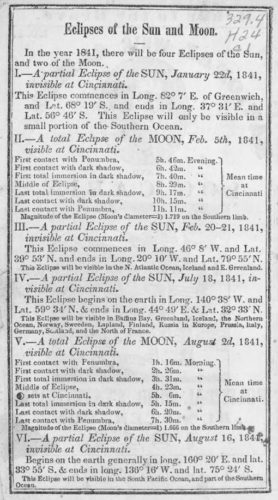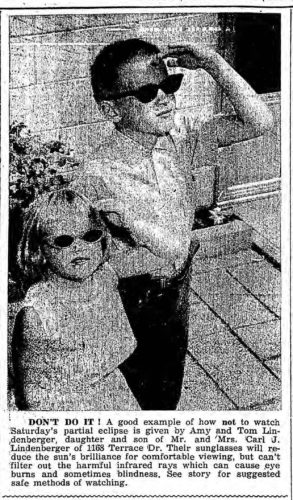“The Fiery Orb Darkened”


This past Monday marked a remarkable astronomical event that you have probably heard about in the news if you didn’t see it for yourself–a total solar eclipse that swept across the contiguous United States in a swath about 70 miles across! Viewers in the path of the eclipse from Oregon on the west coast to South Carolina on the east witnessed a complete obscuring of the sun by the moon, with totality (or the time during which the moon completely covers the sun) lasting between around 2 minutes to 2 minutes and 40 seconds, depending on the viewing location. Ohio, unfortunately, missed out on the total eclipse, but observers all across the state nonetheless got to witness a partial solar eclipse of between 80 and 90 percent!
Eclipses, both total and partial, occur throughout the world on a highly predictable basis, but that doesn’t make them any less awe-inspiring–including to Ohioans of the past! Although Ohio Memory doesn’t include any historical photographs of eclipses, frequent mention is made in newspapers throughout the state’s history, whether or not the eclipse touched Ohio. You can read accounts of eclipses through the years from papers like the Cadiz Sentinel in 1834, the Daily Ohio Statesman in 1869 (with a great summary of historical eclipses), and the Zanesville Signal in 1900, which reports on President McKinley’s viewing of an eclipse in Virginia (though it was sadly too cloudy in Ohio). The Alliance Review announces the June 8, 1918, eclipse in that day’s issue, which was the last total solar eclipse to cross the entire contiguous U.S. until last Monday.

The Shelby County Democrat, on August 13, 1869, gives a wonderful description of the eclipse experience, when “the darkness was equal to that of a moonlight night, […] countenances of the spectators assumed a ghastly unnatural hue [and] the sky was a light purplish color, excepting near the horizon, where the aspect was of that golden radiance with which it glows after a beautiful sunset.” It also recounts the appearance of Baily’s beads, a phenomenon associated with total solar eclipses where “beads” of sunlight appear around the dark shape of the moon.
One thing that is critical to remember during a partial or total solar eclipse is the importance of eye safety. Early newspapers recount the damage done to the eyes of observers who tried to watch the eclipse without eye protection, while later papers encourage readers to follow safety recommendations or to construct a pinhole viewer to experience the eclipse. The image at right, from (fittingly) the North Canton Sun on July 17, 1963, demonstrates what not to do, followed by tips about how to observe the sun safely. Later papers discourage the use of “smoked glass” (a sheet of glass which has been darkened with the residue from smoke), which is commonly mentioned in earlier articles as a viewing tool.
Good news for Ohioans is that in just seven more years, on April 8, 2024, another total solar eclipse will sweep across the United States, and the path of totality will cover more than half of our state! As you wait for this next great chance to view the incredible sight of a total eclipse, we hope you’ll learn more about this fascinating phenomenon on Ohio Memory!
Thanks to Lily Birkhimer, Digital Projects Coordinator at the Ohio History Connection, for this week’s post!



Leave a Reply
You must be logged in to post a comment.